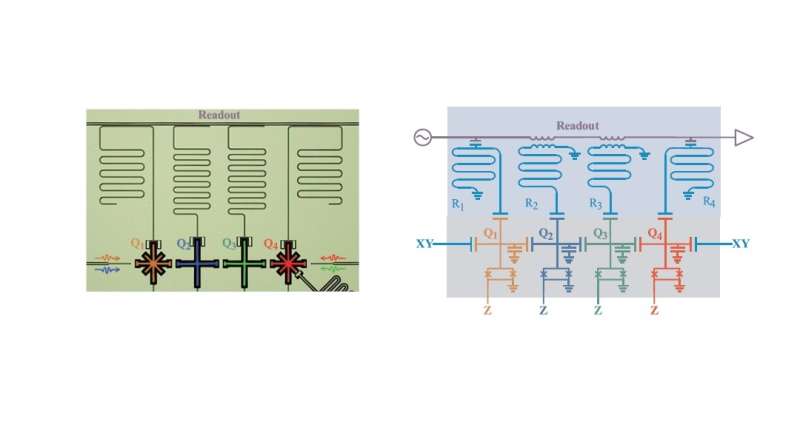June 9, 2017 feature
Solving systems of linear equations with quantum mechanics

(Phys.org)—Physicists have experimentally demonstrated a purely quantum method for solving systems of linear equations that has the potential to work exponentially faster than the best classical methods. The results show that quantum computing may eventually have far-reaching practical applications, since solving linear systems is commonly done throughout science and engineering.
The physicists, led by Haohua Wang at Zhejiang University and Chao-Yang Lu and Xiaobo Zhu at the University of Science and Technology of China, along with their coauthors from various institutions in China, have published their paper on what they refer to as a "quantum linear solver" in a recent issue of Physical Review Letters.
"For the first time, we have demonstrated a quantum algorithm for solving systems of linear equations on a superconducting quantum circuit," Lu told Phys.org. "[This is] one of the best solid-state platforms with excellent scalability and remarkable high fidelity."
The quantum algorithm they implemented is called the Harrow, Hassidim, and Lloyd (HHL) algorithm, which was previously shown to have the ability, in principle, to lead to an exponential quantum speedup over classical algorithms. However, so far this has not been experimentally demonstrated.
In the new study, the scientists showed that a superconducting quantum circuit running the HHL algorithm can solve the simplest type of linear system, which has two equations with two variables. The method uses just four qubits: one ancilla qubit (a universal component of most quantum computing systems), and three qubits that correspond to the input vector b and the two solutions represented by the solution vector x in the standard linear system Ax = b, where A is a 2 x 2 matrix.
By performing a series of rotations, swappings of states, and binary conversions, the HHL algorithm determines the solutions to this system, which can then be read out by a quantum nondemolition measurement. The researchers demonstrated the method using 18 different input vectors and the same matrix, generating different solutions for different inputs. As the researchers explain, it is too soon to tell how much faster this quantum method might work since these problems are easily solved by classical methods.
"The whole calculation process takes about one second," Zhu said. "It is hard to directly compare the current version to the classical methods now. In this work, we showed how to solve the simplest 2 x 2 linear system, which can be solved by classical methods in a very short time. The key power of the HHL quantum algorithm is that, when solving an 's-sparse' system matrix of a very large size, it can gain an exponential speed-up compared to the best classical method. Therefore, it would be much more interesting to show such a comparison when the size of the linear equation is scaled to a very large system."
The researchers expect that, in the future, this quantum circuit could be scaled up to solve larger linear systems. They also plan to further improve the system's performance by making some straightforward adjustments to the device fabrication to reduce some of the error in its implementation. In addition, the researchers want to investigate how the circuit could be used to implement other quantum algorithms for a variety of large-scale applications.
"Our future research will focus on improving the hardware performance, including longer coherence times, higher precision logic gates, larger numbers of qubits, lower crosstalk, better readout fidelity, etc.," Wang said. "Based on the improvement of the hardware, we will demonstrate and optimize more quantum algorithms to really show the power of the superconducting quantum processor."
More information: Yarui Zheng et al. "Solving Systems of Linear Equations with a Superconducting Quantum Processor." Physical Review Letters. DOI: 10.1103/PhysRevLett.118.210504. Also at arXiv:1703.06613 [quant-ph]
Journal information: Physical Review Letters
© 2017 Phys.org



















